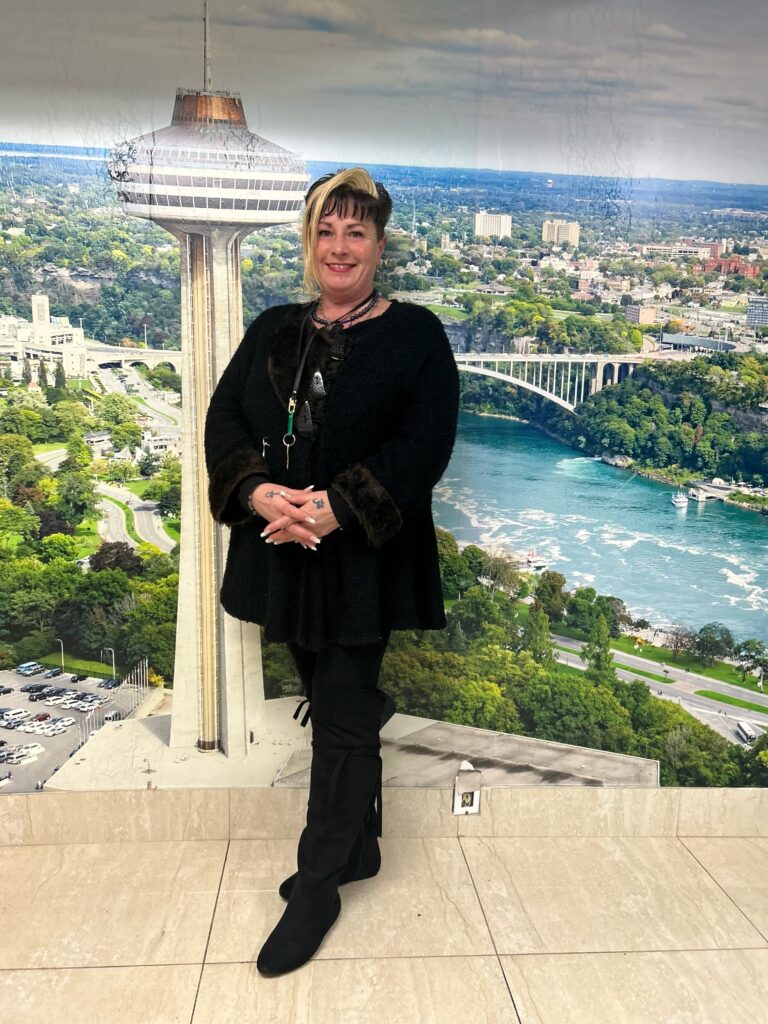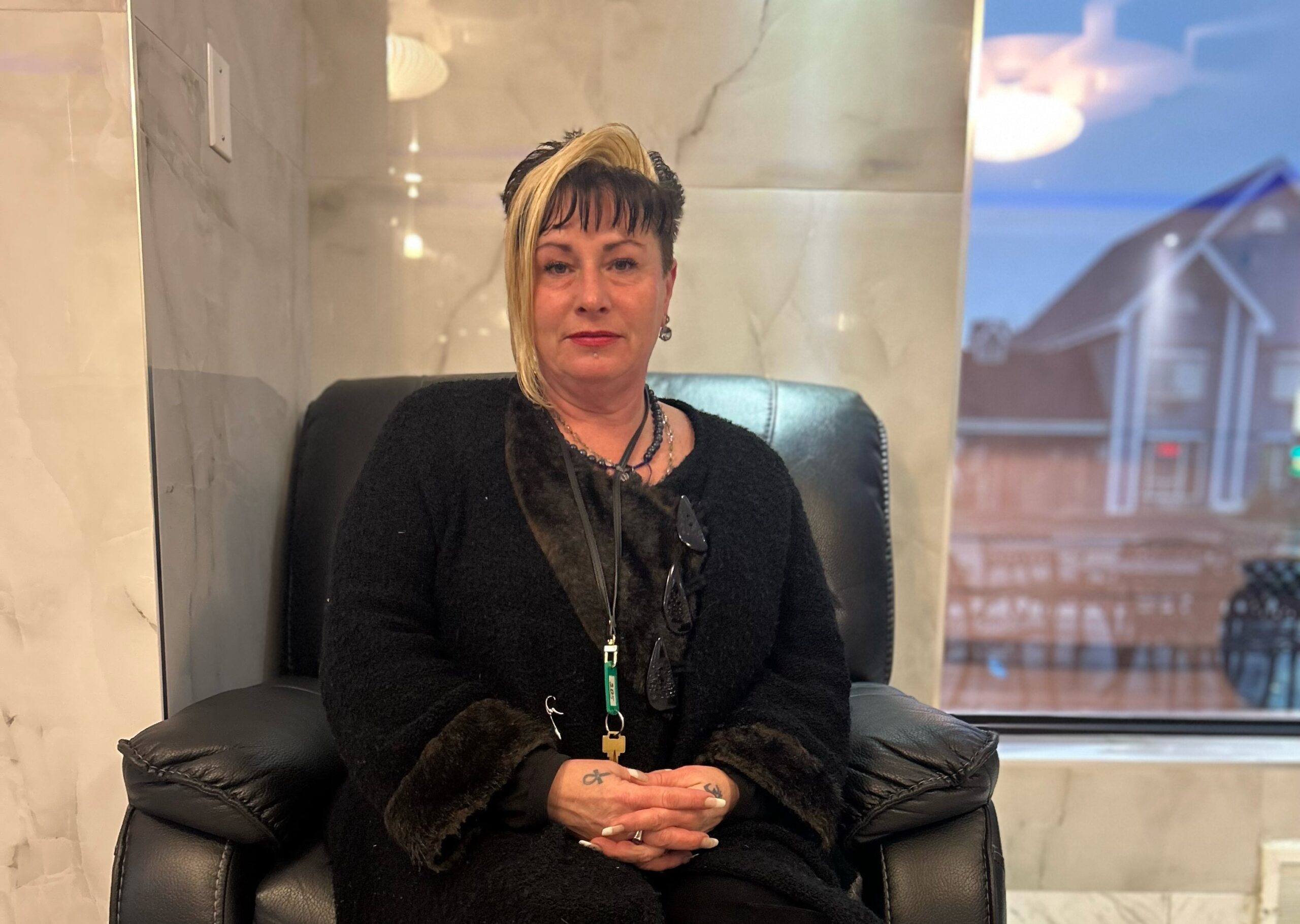Lori Hoyes has been homeless for 14 years.
Fourteen years.
For Christians, the number 14 signifies a double completion. It’s a symbol of deliverance and release.
The Hindu deity Rama was exiled in a forest for 14 years with his wife, Sita, and brother, Lakshman.
For those who consider frequent observations of repeated number sequences (known as angel numbers) as divine guidance, the number 14 signifies positive growth and change, combining the new beginnings of the number 1 and the stability and balance of the number 4.
In the secular world, there’s Guns N’ Roses’ 1991 song, “14 Years,” with lyrics describing 14 years of silence and pain.
In each of these, one might find some resonance with Hoyes’ story. Certainly, her 14 years of homelessness is a kind of exile, with pain and periods of silence from agencies who should provide help. And she is certainly ready for a deliverance of sorts.
Throughout these fourteen years, Hoyes has slept at shelters for periods of time, the GO station sometimes. When she doesn’t have a safe place to sleep, she tries to stay awake at night and sleep during the day, perhaps on a library couch. While the majority of Hoyes’ belongings are in storage, she keeps some necessities with her in her small wheeled suitcase.
“It’s humiliating,” Hoyes says.
All Hoyes wants is a place to live, in Burlington, so that she might have a chance to reconnect with her estranged son, with no involvement by mental health agencies. Hoyes is adamant: she has no need or desire for mental health evaluations or help.

Her wishes for her own healthcare and housing should be respected, Hoyes thinks.
Most people who are housed surely want — expect, even — the same for themselves. Why, then, should Hoyes be any different?
This has not been respected in the past, though, says Hoyes. An apartment was offered to her, but upon questioning, it turned out that the apartment was owned by an agency that helps people with mental health and addictions as well as housing. Hoyes was told that she is actively on the list for housing within the region, but says she struggles to get responses to her queries.
Fourteen years.
Of course, Hoyes’ story starts well before this. Her early years were difficult, with trauma and discord in her childhood home.
She grew up in Burlington. Her father had problems with alcohol, and her mother, who had childhood trauma of her own, was controlling. Hoyes says that her mother was gifted with animals and nature, but seems not to have been able to be as nurturing with her daughter. Hoyes also has an older brother who was not exactly a protective presence.
Hoyes remembers police sometimes coming to the home before her parents’ separation. She notes that she experienced other childhood trauma, but that she has blocked a lot of it. She was exposed to drugs when her brother began taking her to nightclubs in Toronto, far before she was of an age to be able to process that kind of thing. She was about 11 years old at that time, Hoyes explains.
She left home at age 15, and ended up homeless in Hamilton for that summer. She then went to live with her father, who was still not a well-functioning adult. Hoyes ended up renting out rooms to friends to help make ends meet.
Hoyes strived to overcome her struggles, determined to make something of herself. She went to school to learn hairdressing, and began working in St. Catharines. She moved back to Hamilton at age 17, took part-time work barbering, began dating a local guy.
That local guy turned out to lead to trouble for Hoyes. She was exposed to more things that she wasn’t ready for, and she recalls some traumatic experiences with the police during this time.
After a move to Brampton, Hoyes tried to keep clear of trouble. She met her soon-to-be husband when she was 19. They married and had a child, and the family settled in St. Catharines.
Continuing issues with her mother and brother, some of which began to affect her marriage, led to Hoyes cutting off contact with them.
Both Hoyes and her then-husband worked at Ford in Oakville, though Hoyes did not have a good experience there. She experienced aggression from the other workers, who were mainly men. She believes the stress she felt as a result of these working conditions led to her health issues: irritable bowel syndrome, PTSD, a stomach ulcer, high blood pressure, gastroesophageal reflux disease (GERD), and anxiety.
Next came a car accident that required intense physiotherapy. Hoyes was advised that she’d likely be off work for a year, but fear of losing her job got her back to work earlier. She and her husband worked opposite shifts, which was not helpful for their relationship. The harassment she described from male co-workers did not stop. There was also a psychiatrist she was seeing through Ford — that ended, though, when he wanted to change the client/doctor relationship to a more physically intimate one.
Then, another personal trauma: she discovered that her husband had been cheating on her, fathering a child with another woman. This child was 5 years old, Hoyes says, when she found out about their existence.
They remained together regardless, but Hoyes says that the infidelities did not stop. After 19 years together, Hoyes had enough. “I kicked him out.”
Hoyes then ended up taking a buyout package from Ford. “I lost my job, my husband, my house,” Hoyes says.
People from earlier chapters in her life turned up again, people who weren’t necessarily in good places in their own lives. Hoyes was still trying to get back on her feet; she started at Niagara Women’s Enterprise Centre. She began dating a man who soon began manipulating her. Hoyes describes struggling to put food on the table for her son, and selling her truck to help pay bills.
When the dysfunction in her relationship led to further encounters with the police, the Children’s Aid Society (CAS) became involved. Hoyes characterizes this boyfriend’s treatment of her as abuse, but the last straw may have been the way he interacted with Hoyes’ son, and how he expected her to interact with her child. Fear for her son propelled her to report him to the police — no small act for Hoyes given her previous negative experiences with the police.
The outcome of reporting his abuse to the police? Nothing, says Hoyes.
Life seemed to deteriorate from there. “I lost everything,” says Hoyes sadly. “They took away my son. I’ve been arrested four times for crimes I didn’t commit.”
Since she became homeless, Hoyes has lived in eight cities, including being in Oakville from 2012 to 2014. She has stayed at Salvation Army shelters and the Wesley shelter. She tried living in a basement apartment in Oakville, after coming back to Halton four years ago, which devolved into Hoyes being threatened with a knife. “I was arrested and thrown into a psych ward,” Hoyes remembers.
Hoyes is a deeply spiritual person. She carries crystals with her, and goes into deep meditations, both as self-care, and so she can help others, putting protections over others, praying for people. When she was in Niagara, she would “pray over people coming out of bars, keeping people safe.” For that, Hoyes says, she was asked to leave Niagara. In shelters, she’s been called crazy and chastised for her spiritual practices, she says, and her brother spoke to shelter staff at one shelter she stayed at, and tried to have her committed to a mental institution. “Without my consent,” emphasizes Hoyes. She’s been given injections without her permission, she recalls, after police “took me to a psych ward rather than a shelter as I’d been told.”

Then she went “shelter to shelter to shelter.” During COVID, Hoyes was at Halton Lighthouse (Salvation Army) shelter, though she was later “kicked out” due to encounters with the police. There were also issues with getting the proper paperwork filled out for the Halton Access to Community Housing (HATCH) program; much advocating for herself led to that being backdated by a couple of years, but it should be more, says Hoyes.
Later, at the Wesley shelter, when filling out paperwork for placement in permanent housing, Hoyes specified that she “wanted nothing to do with mental health. I don’t require those services and I don’t want them.” Hoyes has been clear about her needs, and does not feel like these have been considered, giving the example of the apartment she was offered that was owned by the mental health, addictions, and housing agency.
Hoyes feels like she has just been slipping through the cracks all these years. From Hoyes’ perspective, shelters and doctors have tried to force mental health services on her and label her with disorders rather than help her solve her biggest challenge — not having a permanent place to live. Given that she is “more than capable of caring for myself independently,” it feels, she says, like she is being targeted and sabotaged. Between her negative experiences with authorities and authority figures dating back to childhood and the fact that she has been homeless for 14 years, Hoyes feels like the system has failed her.
She does receive government assistance, but with the rising cost of living, this will not cover rent at market cost, let alone allow her to buy food as well. Food is somewhat easier to access, via charitable organizations, or purchasing it — but not having a fridge to store food and having to carry it around means that she cannot have more than one day’s food at a time. And she sometimes manages to find a hotel that will give her a small discount for a longer-term stay, but that is only a short-term solution. It is not affordable in even the medium-term.
The result is stress, all the time. She does not eat properly, “not enough nutrients for the energy I’m putting out,” Hoyes explains. She does not suffer from addictions, but not getting enough sleep the majority of the time is a real problem, particularly during the times when she’s sleeping at the library during the day and staying up all night. Safety is an issue, of course, particularly when sleeping at places like GO stations. Hoyes has faced unsafe and violent situations; she’s been robbed, punched, and woken up to find men standing over her, watching her sleep.
On Maslow’s Hierarchy of Needs, the things that Hoyes needs assistance with are the most basic: shelter (permanent, stable shelter), so that she can get sufficient sleep, and store her belongings and food appropriately.
Many of us have noticed an increase in people experiencing homelessness in Burlington, so the conditions under which Hoyes is currently living are not unique to her. Shelters are full. There are waitlists for community or subsidized housing. Back in late September of this year, the Halton Police Services Board heard a report on the increase in small encampments of people experiencing homelessness in both Burlington and Oakville. The concern was such that the Housing and Homelessness Action Table was reactivated in July 2023.
Halton Region’s update on their response to encampments and homelessness in the region (click here to read) notes that staff are aware of gaps in their ability to help people. For instance, the report says that “supportive housing for individuals with complex mental health and addictions challenges remains the most significant gap in Halton’s housing system.” The aforementioned Housing and Homelessness Action Table is now working on “a unified process across all four local municipalities for responding to encampments,” says the report. The report also stated that as of Oct. 1, 2023, in Halton, 172 people were in emergency shelters, 270 people were in “temporary transitional housing awaiting an offer of permanent housing, and 10 to 25 people were sleeping outside in Halton on any given night, most of whom are working with the region’s Street Outreach Team to get permanent housing.
Newcomers to Canada may also find themselves in difficulties: at the November 22 meeting of regional council, Commissioner of Social and Community Services Alex Sarchuk noted that “asylum seekers and refugee claimants who are not supported by the federal government in any real way” have become part of the homeless population in Halton Region to the point that “on any given day, there’s some 20%.”
Even people with stable jobs are finding themselves in the position of having to move and no longer being able to afford current rental rates. Many people are only one personal crisis away from losing their ability to pay rents or mortgages. People end up on the streets for a variety of reasons, each with their own tales of challenges, maybe long-standing issues that over time became worse, until they found themselves without so much as a room to call their own.
But even amongst the homeless, Hoyes stands out: fourteen years is a long time. Too long.
Read Local-news.ca’s previous articles on homelessness in Burlington by Noor Menhel and Hannah Menhel here and here.
Sources:
Halton Region. Nov. 22, 2023. SS-26-23 Update on homelessness and encampment responses in Halton Region. Url: https://edmweb.halton.ca/OnBaseAgendaOnline/Documents/ViewDocument/SS-26-23%20 (accessed Dec. 2, 2023).
Halton Regional Police Service. Community safety and well-being status report May 2023–September 2023. Public agenda of Halton Police Board meeting, Thursday, September 28, 2023. Url: https://haltonpoliceboard.ca/wp-content/uploads/2023/09/HPB-Public-Agenda-September-28-2023.pdf (accessed Dec. 2, 2023).
Maslow, A.H. 1954. Motivation and Personality. Harper & Row Publishers, Inc., New York.





